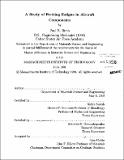A study of fretting fatigue in aircraft components
Author(s)
Birch, Paul R. (Paul Robert), 1974-
DownloadFull printable version (10.01Mb)
Advisor
Subra Suresh and Antonios E. Giannakopoulos.
Terms of use
Metadata
Show full item recordAbstract
This thesis presents theoretical, computational, and experimental approaches to the problem of fretting fatigue in materials systems relevant to aircraft components. The basic contact mechanics for fretting fatigue in a sphere-plane contact geometry are reviewed. Various elastic criteria for predicting fretting failure are discussed; selected fretting maps created from one of these - the modified Crossland criterion -- are presented. Fail/no-fail predictions based on these maps have verified trends observed in experimental work performed on Al 7075-T6 specimens. A three-dimensional finite element model of sphere-plane fretting contact is reviewed. This model has been used to model elastic and elastoplastic fretting contact. The evolution of tangential loads coincident with plastic flow has been simulated, as well as the accumulation of equivalent plastic strains for these fretting conditions. This information may be used to predict the life of components subject to fretting contact high cycle fatigue (HCF) via a Coffin-Manson type relation. Design and construction of an apparatus for performing quantitative fretting experiments are described, and results of early tests performed on 7075-T6 aluminum alloys are presented. These experiments validate the proper operation of the experimental apparatus. Finally, basic principles of fracture mechanics and the limitations of applying traditional linear elastic fracture mechanics (LEFM) to fretting fatigue are discussed. The new crack analogue concept of Giannakopoulos et al. is reviewed as a means of uniting LEFM and fretting contact mechanics to achieve a life prediction scheme for components subject to HCF that is superior to the modified Goodman diagram approach currently employed by the US Air Force.
Description
Thesis (S.M.)--Massachusetts Institute of Technology, Dept. of Materials Science and Engineering, 1998. Includes bibliographical references (p. 145-152).
Date issued
1998Department
Massachusetts Institute of Technology. Department of Materials Science and EngineeringPublisher
Massachusetts Institute of Technology
Keywords
Materials Science and Engineering